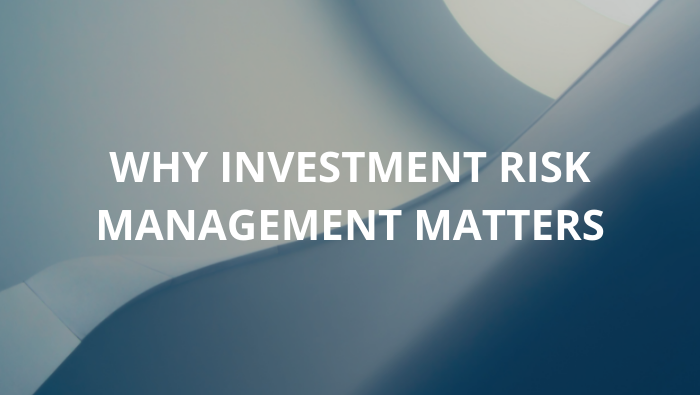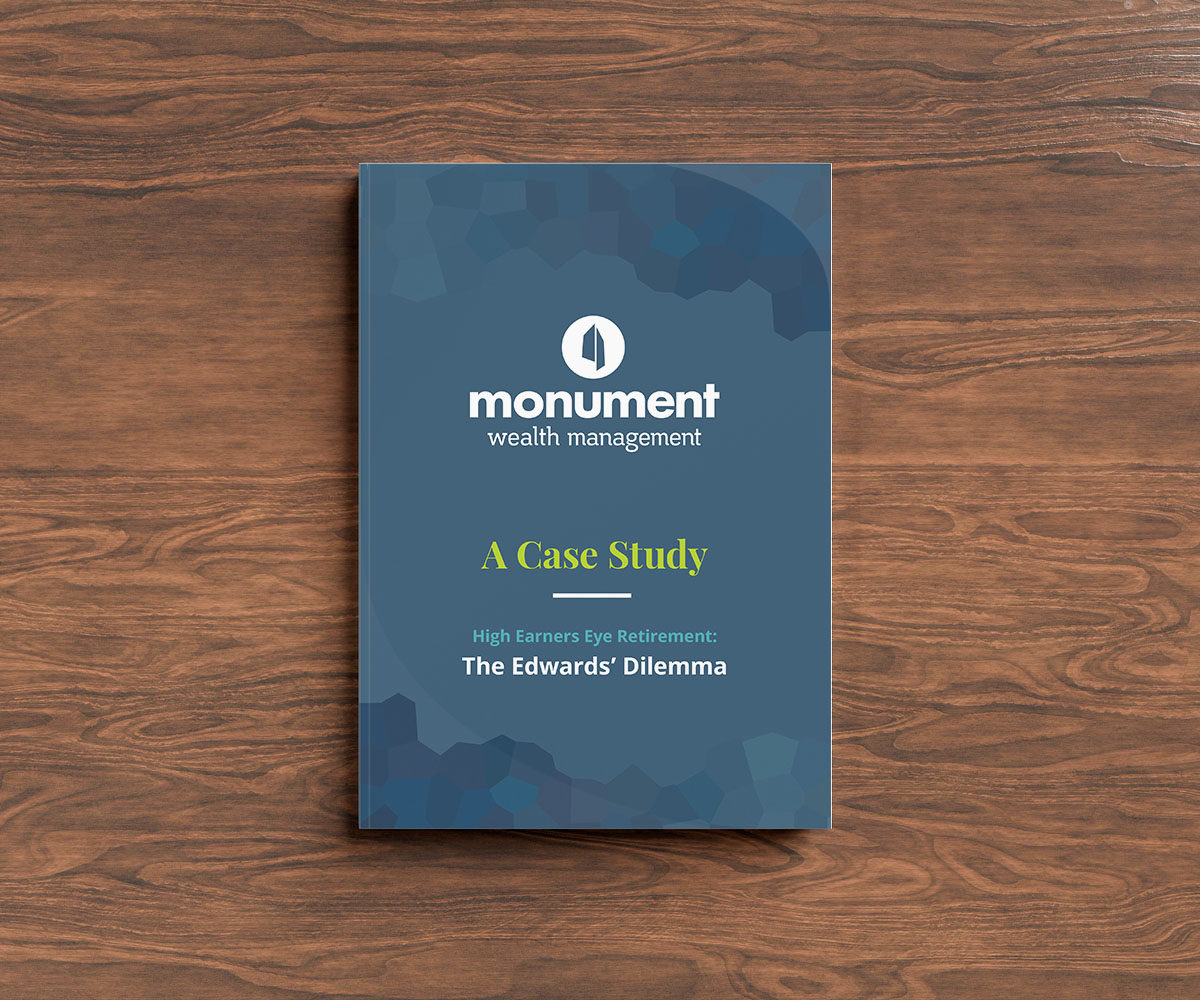Monument Wealth Management Articles
Investment Risk Management: 4 Ways To Avoid Portfolio Drawdowns

Share on your favorite platform, or by email
Drawdown measures an investment’s, fund’s, or portfolio’s decline from a peak to a trough, usually expressed as a percentage. So, for example, if Stock XYZ dropped from $100 to $80 during a certain period before recovering back to $100 or above, you’d have a 20% drawdown recorded for that stock. Essentially, drawdowns provide a way to help determine a stock’s financial risk. In theory, the higher the drawdown the more inherent volatility there may be.
Watching your portfolio plummet doesn’t exactly inspire great feelings and can cause you to do, well, stupid things. Since portfolio drawdowns do happen, here are a few investment risk management tips you can use to lessen the impact of drawdowns in your portfolio.
1. Diversify your portfolio
This classic piece of investment advice is everywhere for a good reason.
Spreading your investments across numerous asset classes and sectors reduces your portfolio’s reliance on any particular one. It’s meant to mitigate your loss—if one sector were to decrease, your diversification across multiple sectors can reduce the impact of those losses.
There are levels of diversification, too. For example:
- Owning multiple types of the same asset class, such as stocks from different sectors
- Owning assets in multiple different asset classes, such as stocks, bonds, and real estate
- Owning assets with different risk levels
Be aware: Some markets historically have had an inversely proportional relationship to others—meaning, when one market goes up the other tends to go down.
A classic example are stocks and bonds. When stocks go up, bonds tend to decrease and vice-versa. Having both in your portfolio can help limit your risk and stabilize your portfolio if you are at a point with your financial plan where you may be really focused on protecting your nest egg.
2. Consider lump sum investing
Some investors prefer to dollar-cost average their way into assets. This involves buying smaller, consistent amounts of assets at regular intervals. However, lump-sum investing could be another way to go—as long as you adjust your asset allocation accordingly.
What do we mean?
If one asset class in your portfolio begins a downward trend, you might lump sum your way into another asset class that’s on its way up. Assuming these trends continue, the declining asset will make up a smaller percentage of your overall portfolio, reducing portfolio drawdown.
So as the markets move and you add more money to your investment portfolio, you’ll need to watch your overall allocation and make sure it still aligns with your overall investment strategy and goals–or adjust as needed.
3. Hedge your investments
Hedging involves buying certain financial instruments to potentially offset the risk of other assets. This typically starts with buying “portfolio insurance,” which is essentially one of two options:
- Taking the opposite position on one of your investments- If you’re in a long position on Stock A, you may consider shorting some of that stock in case it decreases in value. Should the stock drop, your shorts could make up for some of that decline.
- Buying certain derivatives- Once again, say you’re long in Stock A. Purchasing a put option could allow you to offset some of those options by giving you the right (but not the obligation) to sell Stock A at a specific price.
In either example, you reduce some of your long position exposure and minimize drawdown. Remember though, options investing can be risky, so seek advice from a knowledgeable source before you jump in.
4. Keep some cash on the sidelines
The most simple, straightforward, and foolproof way to shield yourself from the impact of market drawdowns is to always have 12-18 months of cash on hand. That way, you can still cover your expenses and don’t have to sell when the market is down.
But there’s another benefit to keeping some cash–you can take advantage of lower prices. Once that drawdown occurs, you can buy those same assets for much cheaper and wait for them to increase.
Design a strategy that slows portfolio drawdown
The reality is that drawdowns are part of the game. Employing certain investment risk management strategies can help to minimize the impact of them while meeting your goals.
A strategy that includes dynamic asset allocation—making frequent adjustments to your portfolio’s mix of asset classes to increase the weights of higher-performing assets—might be a good idea. This type of dynamic rebalancing strategy is offered by select wealth managers and often utilized by both high net worth individuals and institutions alike. At Monument, we call it our “Flexible Asset Allocation” and with our Private Wealth Design service, we customize your portfolio around minimizing drawdowns using tactics we’ve learned through decades of experience.
Don’t worry, we don’t have a stuffy, intimidating office either. We want to help you understand what’s going on in your portfolio and why–so you can feel as comfortable as we do planning for your financial future.
Bottom line: If you’re looking for help reaching your financial goals from experts that provide complete transparency and clarity, we should talk.

It’s time to find clarity around your finances and remove the anxiety of the unknown.
Read our case study, “High Earners Eye Retirement,” to see how we helped one of our clients plan for the long term.
Ready for straightforward, unfiltered opinion and tailored advice for YOUR questions, not everyone else’s?
IMPORTANT DISCLOSURE INFORMATION
Please remember that past performance is no guarantee of future results. Different types of investments involve varying degrees of risk, and there can be no assurance that the future performance of any specific investment, investment strategy, or product (including the investments and/or investment strategies recommended or undertaken by Monument Capital Management, LLC [“Monument”]), or any non-investment related content, made reference to directly or indirectly in this blog will be profitable, equal any corresponding indicated historical performance level(s), be suitable for your portfolio or individual situation, or prove successful. Due to various factors, including changing market conditions and/or applicable laws, the content may no longer be reflective of current opinions or positions. Moreover, you should not assume that any discussion or information contained in this blog serves as the receipt of, or as a substitute for, personalized investment advice from Monument. To the extent that a reader has any questions regarding the applicability of any specific issue discussed above to his/her individual situation, he/she is encouraged to consult with the professional advisor of his/her choosing. No amount of prior experience or success should be construed that a certain level of results or satisfaction will be achieved if Monument is engaged, or continues to be engaged, to provide investment advisory services. Monument is neither a law firm nor a certified public accounting firm and no portion of the blog content should be construed as legal or accounting advice.
A copy of Monument’s current written disclosure Brochure discussing our advisory services and fees is available for review upon request or at www.monumentwealthmanagement.com/disclosures. Please Note: Monument does not make any representations or warranties as to the accuracy, timeliness, suitability, completeness, or relevance of any information prepared by any unaffiliated third party, whether linked to Monument’s website or blog or incorporated herein, and takes no responsibility for any such content. All such information is provided solely for convenience purposes only and all users thereof should be guided accordingly.
Historical performance results for investment indices, benchmarks, and/or categories have been provided for general informational/comparison purposes only, and generally do not reflect the deduction of transaction and/or custodial charges, the deduction of an investment management fee, nor the impact of taxes, the incurrence of which would have the effect of decreasing historical performance results. It should not be assumed that your Monument account holdings correspond directly to any comparative indices or categories. Please Also Note: (1) performance results do not reflect the impact of taxes; (2) comparative benchmarks/indices may be more or less volatile than your Monument accounts; and, (3) a description of each comparative benchmark/index is available upon request.
Please Remember: If you are a Monument client, please contact Monument, in writing, if there are any changes in your personal/financial situation or investment objectives for the purpose of reviewing/evaluating/revising our previous recommendations and/or services, or if you would like to impose, add, or to modify any reasonable restrictions to our investment advisory services. Unless, and until, you notify us, in writing, to the contrary, we shall continue to provide services as we do currently. Please Also Remember to advise us if you have not been receiving account statements (at least quarterly) from the account custodian.